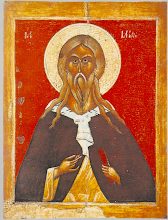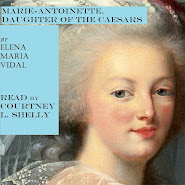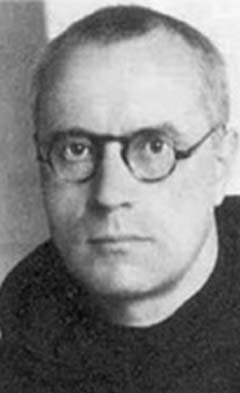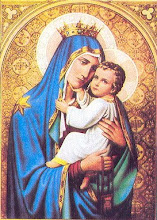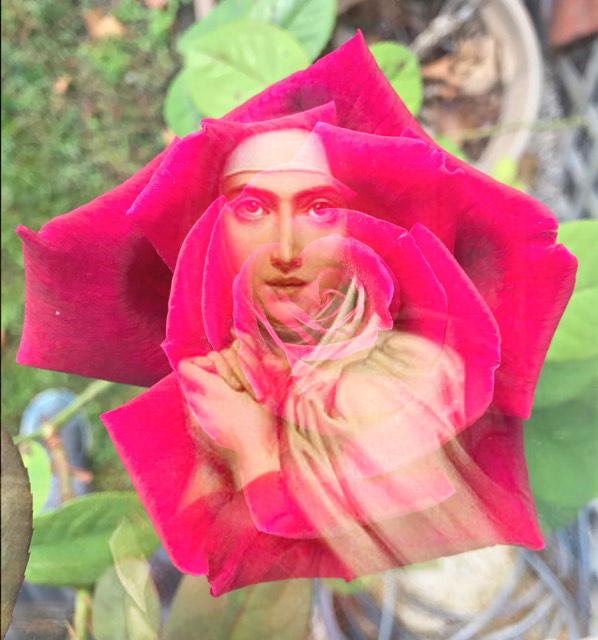I pray for those who hate me,
for those who resent me
and for those who have spoken ill of me.
I beg you to bless them abundantly
and to pour into their hearts
such a profusion of healing mercies
that in them and around them
love will triumph over hatred,
friendship over resentment,
sweetness over bitterness,
meekness over anger,
and peace over enmity.
I further ask you to extend these graces
to their families and to all whom they hold dear.
Wednesday, June 23, 2010
Praying for Enemies
Fr. Mark has a remarkable prayer to the Sacred Heart for all those who have wished us ill.
Friday, June 18, 2010
The Immaculata
The Virgin of the Apocalypse. Our Lady has told us how to live in difficult times.
This is why true devotion to Our Lady is so important in our day. We need to draw close to the Blessed Virgin in prayer, through some form of daily devotion, be it so simple as the devotion of the Three Hail Marys, the Little Office, or the Rosary. Of all devotions the Rosary is the most highly recommended and something Our Lady herself has requested. Therefore it is accessible to all - it just takes practice to incorporate into our daily lives - especially when most of us are busy with work, daily necessities and family obligations.
Thursday, June 17, 2010
Tuesday, June 15, 2010
The Church as Bride
A magnificent meditation from Anthony Esolen.
I love this Church, this bride, this sheepfold, this ark, this glorious cathedral. I love the soaring visions of blessedness that inspired the glaziers of the rose windows of Chartres; and I love, sometimes I am not sure why, the same Church that has turned louche show tunes into hymns for the common people. I love the Church for which St. Thomas Aquinas wrote his great compendia of theology and philosophy, dictating, it is said, four separate books to four secretaries simultaneously as he paced about his room; and I love the Church that sells simple holy cards to old women who miss their beloved dead. I love the Church that celebrates the sacrament of the altar under Bernini's baldacchino at St. Peter's, and in a bamboo hut in Africa; a Church of untold riches, and sometimes terrible poverty. I love a Church great enough to exalt a middle-class girl dying of consumption, a Therese of Lisieux, to the status of doctor, a teacher of endurance and faith amid suffering. I love a Church whose saints shine forth in beauty -- a simple Francis of Assisi, hymning the goodness of all creation; a King Louis IX, meting out justice and mercy under a tree in Paris; a Mother Teresa, smiling with kindness upon the destitute and the dying of Calcutta. And I love a Church filled to the clerestory with sinners, some of whom make their silent way to the confessional every month or so, while others err at the margins, looking warily but longingly to their Mother, hoping someday to return home.
Saturday, June 12, 2010
A New Carmelite Martyr
From Louange de sa Gloire:
More HERE.
Joseph Mazurek was born March 1, 1891, in Baranowka, Poland. He attended the Minor Seminary of the Discalced Carmelites and in 1908, received the Carmelite habit and the name Alphonsus Mary of the Holy Spirit. He was ordained a priest in July, 1916. Because of his ability as an organizer and educator, Father Alphonsus was made prefect and professor at the minor seminary he had attended as a youth. He continued at the seminary until 1930 when he was elected prior (superior) of the Carmelite monastery at Czerna. It was at this monastery that he would work and live until his death. The new prior threw himself into his new responsibilities. Although the monastery was far from town, Father Alphonsus rekindled the apostolic work of the group. He also organized Carmelite devotions. The prior impressed all with his zeal and dedication to his priestly and religious vocation. The Nazis had begun occupying the area in 1939, but this did not stop the Carmelites from living their religious lives to the full. In spite of the threat of retaliation, the Carmelites continued to accept novices into their community and helped the refugees as best they could. In August of 1944, one of the Carmelite novices was shot. Shortly afterwards, the Nazis forced the friars to another village to dig war trenches. Father Alphonsus Mary was separated from his community and forced into a car where he was assaulted. When the car finally stopped Father Alphonsus was pushed out and told to start walking. Soldiers fired at him and the priest fell. When the murderers realized he was not dead, they filled his mouth with dirt, put his body in a horse drawn carriage and drove to a nearby cemetery. Providentially, the carriage passed the other friars on their way to dig the trenches. One of his brother priests was able to give Father Alphonsus absolution before he died. Throughout his torture and death, the priest had a rosary clutched in his hands. The Carmelites buried their prior and despite the curfew, many people attended the funeral. Father Alphonsus was murdered on August 28, 1944, at the age of fifty-three. In a letter to Carmelites throughout the world, the Superior General of the Carmelite order calls Father Alphonsus’s martyrdom the “crowning of a life of fidelity”. Father Alphonsus himself, in his writings states: “All our sanctity and perfection consists in conforming ourselves to the will of God, which is the sole and supreme rule of perfection and of holiness.” For his fellow Carmelites and the people of the surrounding area, Father Alphonsus was immediately revered as a martyr. In September, 1945, the Carmelites at Czerna built a monument over the spot where Father Alphonsus was shot. On the monument it says, in part, “...We do not pray for you; because the enemy has snapped the thread of an innocent’s life; since, when the earth bled, the Lord looked for the victim who had overcome hatred by love.” Father Alphonus Mary was one of the one hundred eight Polish martyrs beatified in 1999.
-- Biography from the Discalced Carmelite Generalate
More HERE.
Friday, June 11, 2010
A Summons to Purification
The Pope speaks on the solemnity of the Sacred Heart.
It was to be expected that this new radiance of the priesthood would not be pleasing to the "enemy"; he would have rather preferred to see it disappear, so that God would ultimately be driven out of the world. And so it happened that, in this very year of joy for the sacrament of the priesthood, the sins of priests came to light - particularly the abuse of the little ones, in which the priesthood, whose task is to manifest God's concern for our good, turns into its very opposite. We too insistently beg forgiveness from God and from the persons involved, while promising to do everything possible to ensure that such abuse will never occur again; and that in admitting men to priestly ministry and in their formation we will do everything we can to weigh the authenticity of their vocation and make every effort to accompany priests along their journey, so that the Lord will protect them and watch over them in troubled situations and amid life's dangers.
Tuesday, June 8, 2010
Prayer Request
I ask prayers for a special intention. I have some big decisions to make. For one thing, as I mentioned on the Tea at Trianon blog, we have a chance to move closer to my family in Maryland. There are some obstacles, however, which need the divine intercession. Please pray for me.
Monday, June 7, 2010
The Sacred Origins of Hierarchy
Thanks to Fr. Mark for the clear explanation of a greatly misunderstood concept in our egalitarian society.
In the last decades, the adjective "pastoral" has often been used almost in opposition to the concept of "hierarchical," exactly as the idea "communion" has also been interpreted in the very same opposition. This is perhaps the point where a brief observation might be useful on the word "hierarchy," which is the traditional designation of the structure of sacramental authority in the Church, ordered according to the three levels of the sacrament of holy orders: episcopate, presbyterate, diaconate. Prevailing in public opinion, for this reality of "hierarchy," is the element of subordination and the juridical element; because of this for many the idea of hierarchy appears in contrast to the flexibility and the vitality of the pastoral sense and even contrary to the humility of the Gospel. But this is a badly understood sense of hierarchy, caused also historically by abuses of authority and careerism, which are in fact abuses and do not stem from the very being of the reality of "hierarchy.
The common opinion is that "hierarchy" is always something linked to domination and thus does not correspond to the true sense of the Church, of unity in the love of Christ. But, as I have said, this is a mistaken interpretation, which has its origin in abuses of history, but does not correspond to the true meaning of what the hierarchy is.
Let us begin with the word. Generally, it is said that the meaning of the world hierarchy is "sacred dominion," but the real meaning is not this, it is "sacra origine," that is: This authority does not come from man himself, but has its origin in the sacred, in the sacrament; hence it subjects the person to the vocation, to the mystery of Christ; it makes of the individual a servant of Christ and only insofar as he is a servant of Christ can he govern, guide for Christ and with Christ. Because of this, whoever enters in the sacred order of the sacrament, the "hierarchy," is not an autocrat, but enters in a new bond of obedience to Christ: he is tied to him in communion with the other members of the sacred order, of the priesthood. And even the Pope -- point of reference for all the other pastors and for the communion of the Church -- cannot do what he wants; on the contrary, the Pope is custodian of the obedience to Christ, to his word taken up again in the "regula fidei," in the Creed of the Church, and must proceed in obedience to Christ and to his Church. Hence, hierarchy implies a triple bond: first of all, the one with Christ and the order given by the Lord to his Church; then the bond with the other pastors in the one communion of the Church; and, finally, the bond with the faithful entrusted to the individual, in the order of the Church.
Hierarchical Communion
Hence, it is understood that communion and hierarchy are not contrary to one another, but condition each other. Together they are only one thing (hierarchical communion). Hence, the pastor is pastor precisely when guiding and protecting the flock and at times impeding its dispersal. Outside a clearly and explicitly supernatural vision, the task of governing proper to priests is not comprehensible. But, sustained by true love for the salvation of each member of the faithful, it is particularly precious and necessary also in our time. If the goal is to take the proclamation of Christ and lead men to the salvific encounter with him so that they will have life, the task of guiding is configured as a service lived in total donation for the upbuilding of the flock in truth and in sanctity, often going against the current and remembering that the one who is the greatest must be made the smallest, and one who governs, must be as one who serves (cf. Lumen Gentium, 27).
The Humble Kingship of the Cross
Where can a priest today get the strength for such exercise of his ministry, in full fidelity to Christ and to the Church, with a total dedication to the flock? There is only one answer: in Christ the Lord. Jesus' way of governing is not that of domination, but it is the humble and loving service of the washing of the feet, and Christ's kingship over the universe is not an earthly triumph, but finds its culmination on the wood of the cross, which becomes judgment for the world and point of reference for the exercise of authority that is the true expression of pastoral charity. The saints, and among them St. John Mary Vianney, exercised with love and dedication the task of caring for the portion of the People of God entrusted to them, showing also that they were strong and determined men, with the sole objective of promoting the true good of souls, able to pay in person, to the point of martyrdom, to remain faithful to the truth and to the justice of the Gospel.
Sunday, June 6, 2010
Corpus Christi 2010: Jesus Our Priest
The Pope speaks.
The priesthood of the New Testament is closely bound to the Eucharist. Because of this, today, on the solemnity of Corpus Domini and almost at the end of the Year for Priests, we are invited to meditate on the relationship between the Eucharist and the priesthood of Christ. Oriented in this direction also are the first reading and the responsorial psalm, which present the figure of Melchizedek.
The brief passage from the Book of Genesis (cf. 14:18-20) states that Melchizedek, king of Salem, was "priest of God Most High," and because of this "offered bread and wine" and "blessed Abram," returning from a victory in battle; Abram himself gave him a tenth of everything. The Psalm, in turn, contains in the last verse a solemn expression, an oath of God himself, who declares to the King Messiah: "You are a priest for ever after the order of Melchizedek" (Psalm 110:4); thus the Messiah is not only proclaimed king, but also priest.
From this passage the author of the Letter to the Hebrews takes the cue for his ample and articulated exposition. And we re-echoed it in the refrain: "You are a priest for ever, Lord Christ": virtually a profession of faith, which acquires a particular meaning in today's feast. It is the joy of the community, the joy of the whole Church that, contemplating and adoring the Most Blessed Sacrament, recognizes in it the real and permanent presence of Jesus as High and Eternal Priest.
The second reading and the Gospel, instead, draw attention to the Eucharistic mystery. The First Letter to the Corinthians (cf. 11:23-26) treats the fundamental passage in which St. Paul recalls to that community the meaning and value of the "Lord's Supper," which the Apostle had transmitted and taught, but which risked being lost. The Gospel is the account of the miracle of the loaves and fishes, according to St. Luke: a sign attested by all the Evangelists, which announces beforehand the gift that Christ will make of himself, to give humanity eternal life.
Both of these texts highlight Christ's prayer, in the act of breaking the bread. Of course there is a clear difference between the two moments: When he multiplies the loaves and fishes for the crowd, Jesus thanks the heavenly Father for his Providence, confident that he will not have food lacking for all those people. In the Last Supper, instead, Jesus transforms the bread and wine into his own Body and Blood, so that the disciples can nourish themselves from him and live in profound and real communion with him.
The first thing that one must remember is that Jesus was not a priest according to the Jewish tradition. His was not a priestly family. He did not belong to the lineage of Aaron, but rather to that of Judah; hence, legally, he was precluded from the way of the priesthood. The person and activity of Jesus of Nazareth were not placed in the line of the ancient priests, but rather in that of the prophets....
Now, in what sense is Jesus a priest? The Eucharist itself says it. We can begin from those simple words that describe Melchizedek: he "offered bread and wine" (Genesis 14:18). It is what Jesus did in the Last Supper: He offered bread and wine, and in that gesture he summarized all of himself and all of his mission. In that act, in the prayer that preceded it and in the words that accompanied it, is all the sense of the mystery of Christ, as it is expressed in the Letter to the Hebrews in a decisive passage, which it is necessary to quote. "In the days of his flesh," wrote the author referring to Jesus, "Jesus offered up prayers and supplications, with loud cries and tears, to him who was able to save him from death, and he was heard for his godly fear. Although he was a Son, he learned obedience through what he suffered; and being made perfect he became the source of eternal salvation to all who obey him, being designated by God a high priest after the order of Melchizedek" (5:8-10).
In this text, which clearly alludes to the spiritual agony of Gethsemane, Christ's passion is presented as a prayer and an offering. Jesus faces his "hour," which leads him to death on a cross, immersed in a profound prayer, which consists in the union of his own will with that of the Father. This twofold and unique will is a will of love. Lived in this prayer, the tragic trial that Jesus faces is transformed into offering, into living sacrifice.
Tuesday, June 1, 2010
A Miracle of the Eucharist
According to Zenit:
The miracle occurred Aug. 14, 1730, eve of the feast of the Assumption of the Virgin Mary. That day in all the churches of Siena the priests consecrated additional hosts for those who might wish to receive the Body of Christ the following day.
That night all the priests of Siena met in the main cathedral of the city for a vigil, leaving their respective churches alone. Some thieves took advantage and entered the Basilica of St. Francis to steal the gold chalice with the consecrated hosts.
The next morning it was discovered that the hosts were not there and a group of faithful found the upper part of the chalice in the middle of the street. Thus it was verified that the Body of Christ had been stolen. The inhabitants of Siena began to pray so that the hosts would be recovered.
Three days later, while a man was praying in the Church of St. Mary of Provenzano, very near the Basilica of St. Francis, he noticed that there was something white inside a box for donations to the poor. Upon investigation, the box was found to contain 351 hosts -- the same number of hosts that had been stolen.
"Those three days were like the days between the Crucifixion and the Resurrection," reflected Father Spring.
The hosts were full of dust and cobwebs. The priests cleaned them with great care. Then there was a day of adoration and reparation. Thousands of faithful arrived in the basilica in thanksgiving for the finding of the hosts. They were not distributed, it seems, because the Franciscans wanted the pilgrims to adore them until the moment they deteriorated (because on being deteriorated, the real presence of Christ would disappear).
But the hosts remained intact. The people began to consider them miraculous and increasingly pilgrims went to pray before them. A few were distributed on special occasions.
Presence
Today, 280 years later, 223 hosts remain, in the same state they were in the day they were consecrated.
"At different stages they have been examined and they physically retain all the characteristics of a newly made host," explained Father Spring.
In 1914 the most rigorous examination of this miracle was carried out by order of Pope St. Pius X.
"The Sacred Particles turned out to be in perfect state of consistency, lucid, white, perfumed and intact," Father Spring said.
The examination also concluded that the stolen hosts were prepared without special precautions and kept under ordinary conditions that, in normal circumstances should have caused deterioration.
On Sept. 14, 1980, Pope John Paul II traveled to Siena to celebrate the 250th anniversary of this Eucharistic miracle. On going there, he said, "It is the Presence." Personalities such as St. John Bosco and Blessed Pope John XXIII have also prayed before these holy hosts.
For Father Spring, the Eucharistic miracle of Siena "represents a proof of the love of God for us and the presence to sustain us against doubts, difficulties -- the miracle with which God the Father is helping the Church not to be afraid, to live the presence of her founder sent by the Father to do his will."
"Here two miraculous things happen," explained Father Spring pointing to the hosts consecrated almost three centuries ago. "Time does not exist, it has stopped"; and "composite bodies and organic substances are subject to withering. For these hosts, neither fungus nor elements that break them down subsist. It is a living, continuous miracle. We do not know until when the Lord will permit it."
Subscribe to:
Comments (Atom)
